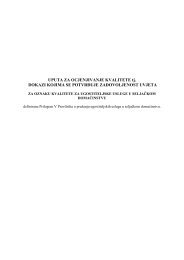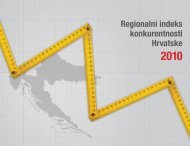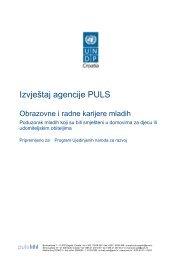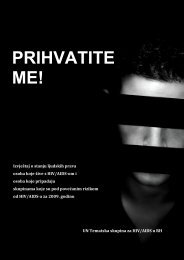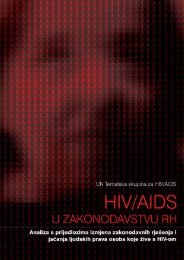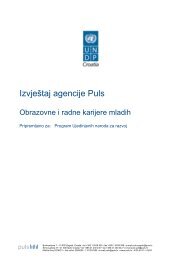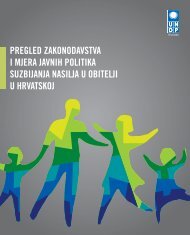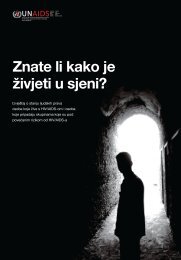WEB engleska verzija end.indd - UNDP Croatia
WEB engleska verzija end.indd - UNDP Croatia
WEB engleska verzija end.indd - UNDP Croatia
- No tags were found...
Create successful ePaper yourself
Turn your PDF publications into a flip-book with our unique Google optimized e-Paper software.
CHAPTER 3THE SOCIALLY EXCLUDEDThe analysis of the current legislation (Turković,2006), as well as the analysis of media coverage ofissues related to HIV, indicate that there are uncertaintiesabout the application of legal measures forthe protection of patients who have been deniedtheir rights. There also appears to be a low level ofknowledge regarding the legal system among thissocial group and their support network. The Analysisof the Applicable Legislation proposes the adoptionof a comprehensive anti-discriminatory law, modificationof certain sub-ordinary legislation which arenot in compliance with international recomm<strong>end</strong>ations,the implementation of education programmesfor representatives of the government and judiciaryon the protection of the rights of vulnerable groups(women, intravenous drug users, men having sexwith men), and building the permanent provision ofsupport to individuals requesting legal protection.Another challenge is determining how to s<strong>end</strong> a messagewhen publishing information about HIV, whileat the same time protecting the rights and freedomsof patients living with HIV who may feel the negativerepercussions from the increased media attention.3.13.12 Policy ImplicationsThe social exclusion of people living with HIV is primarilycharacterized by the overall lack of research andclear data. The experience of people living with HIV atteststo the societal ambivalence where the behaviourof community and institutions may appear protectivein one instance and stigmatising in the other.With regards to the above, the UN Theme Group onHIV in cooperation with CAHIV and the Human RightsCentre are planning to publish in 2007 a report on humanrights and the social status of people living withHIV. This report would document cases of discrimination,problems HIV patients have encountered in realizingtheir rights in the healthcare and social system,and personal stories from people living with HIV. Thereport will help define the greatest and the most frequentproblems encountered by patients living withHIV, help find solutions, and facilitate the monitoringof human rights and the quality of life of people livingwith HIV in <strong>Croatia</strong>.3.14 Sexual Minorities as a VulnerableSocial GroupBox 20: Personal ExperienceN. first decided to visit a well-known psychiatristof an older generation. She concluded that sheneeded expert help - somebody who could helpher find a solution or at least explain to her whatwas happening. She was too confused, worried andtense to handle what had happened on her own.The meeting with the psychiatrist lasted for lessthan ten minutes. Upon her arrival, N. asked if itwas possible to schedule her appointments later inthe afternoon, because she could not come duringthe morning on account of her work. When thepsychiatrist asked her how she managed to makeit that day, N. said that she had asked her boss fora morning off. Trying to be funny, the psychiatristmade the following comment: “Well, your boss mustbe gay.” N. fell silent; then she got up, thanked thepsychiatrist and left the room. It was her intentionto talk to him about what had happened to her afew weeks before when, for the first time in her life,she fell in love with a woman who, after sp<strong>end</strong>inga night with her, decided to ignore her. (From theauthor’s counselling practice).3.14.1 Human RightsIn 1977, homosexual activity was de-criminalized in<strong>Croatia</strong> and several attempts were made during the1980s to sensitise the public to this social group. Thebest-known example of this public awareness campaignwas a radio show, Frigidna utičnica (The FrigidPlug), which aired for some time on Omladinski radio101. Despite these efforts, for most of the public thephenomenon of homosexuality remained largely invisible,although it was frequently present in insults,stereotypical jokes and prejudices (Štulhofer andFrancetić, 1996). During the second half of the 1990s,efforts were made by feminist groups to enhance theunderstanding of lesbianism and to provide supportto lesbian women, which led to the creation of thefirst lesbian association, Lori in 2000. 151 Lori became116151 The first attempt at organising lesbians was connected with the so-called Lila inicijativa (The Purple Initiative), which appeared in1989.



